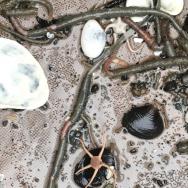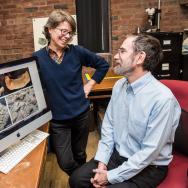Prof. Susan Kidwell has been awarded the 2020 Paleontological Society Medal for her contributions to interpreting the older fossil record and advancing conservation paleobiology.
The Paleontological Society Medal is the most prestigious honor bestowed by the Geological Society of America and is awarded to a person whose eminence is based on advancement of knowledge in paleontology. Kidwell was previously awarded the Society’s early career Charles Schuchert Award in 1995.
“I was delighted, of course, and also amazed,” said Kidwell, the William Rainey Harper Professor of Geophysical Sciences. “I mostly focus on fossils as sedimentary particles, representing the dregs of biological production, so it's pretty wonderful to get this level of recognition for all of us working in this field—taphonomy, which is fundamental but unglamorous.”
She joins fellow taphonomists Kay Behrensmeyer at the Smithsonian and Derek Briggs at Yale who received this medal two and five years ago, respectively. “We are really happy about how our field has evolved,” she said. She also joins four other UChicago recipients of the medal, including current faculty member David Jablonski, who received it three years ago.
Kidwell’s current work is motivated largely by the need to solve modern-day environmental problems. It explores how fossils are preserved and the reliability of paleobiologic data, especially for detecting recent, human-driven changes to ecosystems.
Analyzing fossil records and the sediments that encase them takes Kidwell to oceans all over the world. Her goal is a deeper understanding of why biological remains persist under ordinary conditions—that is, where there is plenty of oxygen to support scavengers and other organisms that can destroy even robust shells and bones, and where rates of burial are very slow. Interpreting those remains reveals insights into the past abundance of species and how the process of burial averages paleobiologic data.
“I develop methods of getting the most information possible from such tattered records, with insights both for geologists, who want to know the mode and tempo of sedimentation and other environmental conditions at the seabed, and for paleobiologists,” Kidwell said.
The Kidwell Lab is currently using the continental shelves of Southern California, the northern Red Sea, and Alaska as study systems.
They are also collaborating with applied ecologists and environmental managers in order to integrate their earth science methods with conventional biological analysis. The dead shells and bones encountered during biological surveys, although usually ignored, retain a reliable record of what natural systems were like in the last few centuries or millennia, before the onset of human stresses and before scientists started monitoring the situation.
“This kind of work—figuring out if and how a system has changed, evaluating human versus natural drivers, and judging targets for restoration—is deeply rewarding,” Kidwell said.

